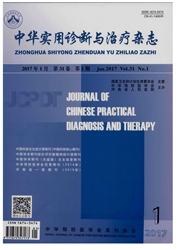

 中文摘要:
中文摘要:
目的探讨心脏型脂肪酸结合蛋白(heart—typefattyacidbindingprotein,H—FABP)预测老年不稳定型心绞痛患者预后的价值。方法年龄≥60岁不稳定型心绞痛患者175例,分为H—FABP阳性组48例和阴性组127例,记录并分析2组资料及12个月随访结果。结果阳性组年龄、体质量指数大于阴性组(P〈0.05),吸烟、冠心病家族史、既往心肌梗死病史、冠状动脉介入和旁路移植手术史及合并糖尿病比例明显高于阴性组(P〈0.05),左室射血分数低于阴性组(P〈0.05);冠状动脉造影显示,阳性组多支、弥漫甚至闭塞病变、累及左主干和前降支比例高于阴性组(P〈0.05);随访12个月,阳性组心脏事件发生率明显高于阴性组(P〈0.01)。结论H-FABP可用于≥60岁不稳定型心绞痛患者的危险分层和1a预后的预测。
 英文摘要:
英文摘要:
Objective To explore the value of heart-fatty acid binding protein (H-FABP) to predicting the prognosis of senile unstable angina pectoris (UAP). Methods A total of 175 UAP patients aged 60 years or older were divided into positive H-FABP group and negative H-FABP group, and were recorded and analyzed the clinical data and 12-month follow-up survey results. Results The age was older, body mass index was larger, and the proportions of smoking history, family history of coronary heart disease, previous myocardial infarction and coronary artery bypass history, and diabetes mellitus were higher in positive group than those in negative group (P〈0.05). The left ventricular ejection fraction was lower in positive group than that in negative group (P〈0.05). Coronary angiography results showed that the rates of multi-vesse lesions, diffusive and occlusive lesions, and left main and left anterior descending lesions were higher in positive group than those in negative group (P〈0.05). After the follow-up survey for 12 months, the incidence of major adverse cardiovascular events was significantly higher in positive group than that in negative group (P〈0.01). Conclusion H-FABP is valuable to identify the high-risk population and to predict the prognosis of UAP patients aged 60 years or older.
 同期刊论文项目
同期刊论文项目
 同项目期刊论文
同项目期刊论文
 Severe coronary artery disease in Chinese patients with abdominal aortic aneurysm: prevalence and im
Severe coronary artery disease in Chinese patients with abdominal aortic aneurysm: prevalence and im A two-year follow-up for Chinese patients with abdominal aortic aneurysm undergoing open/endovascula
A two-year follow-up for Chinese patients with abdominal aortic aneurysm undergoing open/endovascula Comparison of clinical features and outcomes of patients with acute myocardial infarction younger th
Comparison of clinical features and outcomes of patients with acute myocardial infarction younger th Atorvastatin prevents mesenchymal stem cells from hypoxia and serum-free injury through activating A
Atorvastatin prevents mesenchymal stem cells from hypoxia and serum-free injury through activating A 期刊信息
期刊信息
